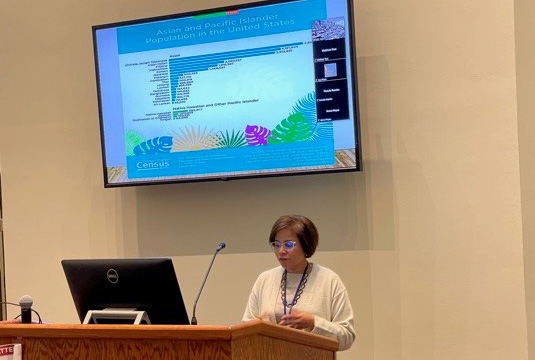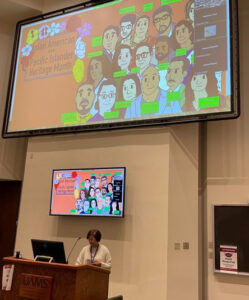View Larger Image

Sara Tariq, M.D., illustrated her talk with graphics.
COVID-19’s Impact on Asian-Americans Significant but Not Well-Documented, Associate Dean Says
| There is a tendency when discussing the impact of COVID-19 in America to treat all Asian Americans and Pacific Islanders as a monolith, Sara Tariq, M.D., associate dean of student affairs in the University of Arkansas for Medical Sciences (UAMS) College of Medicine, told a crowd of mostly students on Nov. 18.
“Painting us with the same brush is very problematic,” she said during the lunchtime lecture. “We’ve got multiple communities that come under the Asian Americans and Pacific Islanders (AAPI) population – Chinese Americans, Asian Indians and Filipino Americans making up the three most populated. We are a very diverse population of people from all over Asia.
“Yet we are often treated as a monolith. We come from very different cultures. We have socio-economic divides. And we live very differently.”
That tendency to group the sub-groups together, coupled with the lack of a common definition of Asian Americans used by reporting entities, makes reliable data about the impact of COVID-19 on Asian Americans hard to come by, Tariq said.
Still, relying on data gathered in areas with larger Asian populations, such as a survey undertaken by Kaiser Family Foundation in San Francisco, she discussed some of the pandemic’s impacts on Asian Americans, as well as the rise in anti-Asian sentiment since the pandemic began, and included some suggestions for mitigating the harm.
Citing reports that a high percentage of Asian Americans sought vaccinations for the disease, she theorized that personal connections to overseas encounters with the virus played a role.
“Maybe they were more worried because they were personally affected by COVID. I’ll tell you this, in the summer of 2020, within a two-month period, we got news that eight of our family members in India died,” Tariq said. “One of them was my first cousin, who was 2 years older than me.”
Another possible factor, she said, was that many Asian American organizations were able to quickly mobilize at the grassroots level to get people to vaccine sites.
She said one study reported that “in New York City, Asian Americans were the greatest subgroup of vaccinated folks – 70%.” Tariq said this was surprising because the same population had to overcome major barriers to get the vaccine, such as verifying their immigration status, language barriers, a lack of reliable Internet service and fear of violence.
“So there were more barriers, but these communities that were organizing at the grassroots level were effectively able to overcome it,” Tariq said.
One possible reason that Asian Americans have generally fared well health-wise during the pandemic is that “wearing masks has traditionally been encouraged in a lot of East Asian cultures,” Tariq said. “So, many Asian Americans started wearing masks before the CDC came out with that recommendation.
“We remember the SARS virus, where so many people died in Hong Kong. In many Asian cultures, collective identity is more important than individual freedoms. It’s about being accountable to one another, so there was not that challenge.”
In discussing reports of anti-Asian violence throughout the pandemic, Tariq noted, “if you Google it, you won’t see the word ‘hate crimes’ very often, but these are absolute hate crimes. It’s important to call them that.”
She said the Kaiser survey indicates there was a higher rate of discrimination experienced by Asian Americans than the 6% reported by members of the group in 2020 and the 33% reported in a follow-up survey this year.
She said reports indicate that there were as many as 100 COVID-related verbal or physical assaults on Asians in California every day during the summer of 2020.
The discrimination experienced by Asian Americans includes being denied jobs or housing, being criticized for speaking a language other than English in public, and being told to “go home,” as well as being accused of spreading or causing COVID-19.
“Many of us have faced this; some of these on different levels,” Tariq said. “We know that a lot of this racism, according to people who have studied anti-Asian hate crimes, has come from our former president referring to the virus as the China virus,” as well as the fact that “a lot of people in leadership positions continue to politicize, and have even weaponized, this language.”
She said social media sites were partly to blame for failing to block racist hashtags that grew exponentially in the three days after President Trump coined the term.
“Social media can cause pain and can affect people’s lives. And it’s really, really important for people to be responsible about that,” she said.
Still, Tariq said, history is partly to blame.
Even though the 1918 influenza pandemic didn’t originate in Spain, “we still use the term Spanish flu,” she said.
The virus, then the deadliest strain of influenza in modern history, killed 20 to 50 million people worldwide as World War I was winding down. Though it had spread across the globe, both Allied Powers and Central Powers nations suppressed news about it to avoid negatively affecting the morale of soldiers. But as one of only a few European countries that remained neutral during the war, Spain was free to report on the pandemic, and not only broke the news but covered it extensively, leading people to assume that it had begun there.
“We’ve got to be really careful on the racialization of infectious disease,” Tariq said.
She said a recent study by Sherry Wang, a researcher at Santa Clara University, showed that during 200 incidents, “there was a very, very low level of bystander interventions, particularly when it comes to Asian American slurs and bias,” which she said “fosters a false consensus that it’s OK to make racist comments or jokes against foreigners.”
Noting that bystanders often “freeze” upon hearing such remarks and cannot quickly offer a proper retort, Tariq said Wang suggested four strategies bystanders can to take to stop a “microaggression,” which often leads to another. They include educating the perpetrator; making the invisible visible by calling attention to the statement; disarming a remark before it can be completed, such as saying, “I don’t want to hear it;” and seeking outside support from someone in a position of power.
She said other successful moves include demanding that elected officials denounce racism against Asians and Asian Americans; setting up hotlines, as was done in New York and Philadelphia, to offer support to victims of hate crimes and bias; writing letters to school districts to ensure bullying is being addressed; and organizing mental health advocacy and anti-stigma campaigns in places of worship.
Tariq said that when she was a medical student at UAMS during the AIDS epidemic she was among about 20 students who organized an effort to visit schools across the state to combat the onslaught of false information.
One way to counteract anti-Asian sentiment during the current pandemic, she said, is by sharing positive information about how Asian Americans have helped the country during this trying time. She referred to Eric Yuan, who was born and raised in Taiwan. Yuan founded the popular video communication tool known as Zoom, which went public in April 2019 and has become wildly popular as a substitute for in-person meetings.
